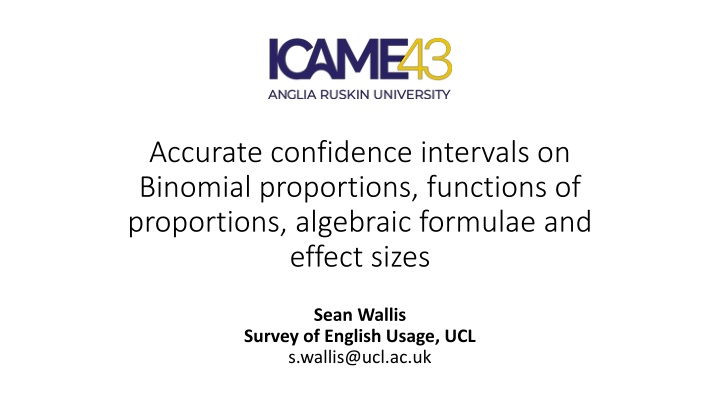
Accurate Confidence Intervals on Binomial Proportions and Effect Sizes
Explore the concept of accurate confidence intervals on binomial proportions, functions of proportions, algebraic formulae, and effect sizes in statistics. Understand the significance of confidence intervals in visualizing uncertainty and identifying differences, along with the history of CI formulas and interpretations.
Download Presentation

Please find below an Image/Link to download the presentation.
The content on the website is provided AS IS for your information and personal use only. It may not be sold, licensed, or shared on other websites without obtaining consent from the author. If you encounter any issues during the download, it is possible that the publisher has removed the file from their server.
You are allowed to download the files provided on this website for personal or commercial use, subject to the condition that they are used lawfully. All files are the property of their respective owners.
The content on the website is provided AS IS for your information and personal use only. It may not be sold, licensed, or shared on other websites without obtaining consent from the author.
E N D
Presentation Transcript
Accurate confidence intervals on Binomial proportions, functions of proportions, algebraic formulae and effect sizes Sean Wallis Survey of English Usage, UCL s.wallis@ucl.ac.uk
Outline Thinking about statistics in terms of confidence intervals The Binomial proportion interval Intervals for functions of single proportions Intervals for functions of independent proportions Intervals for effect sizes Conclusions
Thinking about statistics in terms of confidence intervals Levin (2013) 1 Confidence intervals allow us to visualise the uncertainty of observations identify many significant/ns differences between observations Easier to interpret than tests tests with one degree of freedom may be visualised as an interval p(type | BEthinking) 0.9 cogitate 0.8 0.7 non-significant difference possibly significant difference 0.6 0.5 significant difference 0.4 intend 0.3 0.2 But the history of CIs is littered with inaccurate formulae quotative 0.1 interpretative 0 1920s 1960s 2000s
The Binomial proportion interval We are conventionally presented with the Normal approximation to the Binomial distribution estimate likely position of p given P assume that each observation is independent, has consistent chance of being True or False this chance, P, need not be 0.5 Normal approximation: smooth a Normal curve over the Binomial Possibly include a continuity correction population mean P standard deviation S = P(1 P) / n critical value of Normal z /2, = 0.05 z /2 . S z /2 . S 2.5% 2.5% p 95% 0.1 0.3 0.5 0.7 0.9
The Binomial proportion interval We are conventionally presented with the Normal approximation to the Binomial distribution estimate likely position of p given P assume that each observation is independent, has consistent chance of being True or False this chance, P, need not be 0.5 Normal approximation: smooth a Normal curve over the Binomial Possibly include a continuity correction population mean P standard deviation S = P(1 P) / n critical value of Normal z /2, = 0.05 This is a POPULATION interval It estimates the uncertainty of observations p given P It does not define uncertainty of P given p z /2 . S z /2 . S 2.5% 2.5% p 95% 0.1 0.3 0.5 0.7 0.9
The Binomial proportion interval p = E But in most cases we don t know what the population value P is We have our observed mean, p to model sampling uncertainty about p, we need to invert the relationship, using the same model we need Normal-1(p), not Normal(P) = Wilson score interval (w , w+) this distribution is never Normal asymmetric except where p = 0.5 squeezed between p= 0 and 1 P = w+ E+ z /2 . S z /2 . S w w+ p Wilson (1927)
The Normal fallacy The assumption that uncertainty is Normally distributed about an observation The Wilson distribution is two distributions (lower, upper) each reflects the Normal population distribution on its inner side only The interval is constrainedp [0, 1] distributions cannot be Normal but they do have a relationship with the Normal distribution
Statistical robustness Standard statistical methods assume random sampling (or a good approximation) instances are independent population >> thansample (or infinite) freedom to vary the true value of p(x) can plausibly be 0 or 1 Possible to adjust formulae for random sampling or small populations Freedom to vary guaranteed by mutual substitution:Type A semasiological change (variations in meaning share M1, M2 of Type A) pooled consequence of independent choices (M1: A so analytically preferable to analyse each alternation pattern independently baseline adds information to model Type B (or A B1 B2 etc.) B1, M2: A B2 etc.)
Difference intervals u2 + + w1 w2 Traditionally, to compare two proportions p1 and p2, use a 2 2 contingency table ( 2) tests if d = p2 p1 = 0 We can compute an interval on difference d employ Pythagoras rule (Bienaym theorem) on inner and outer intervals for p1 and p2 (upper right, Newcombe 1998) wd = (w2+ p2)2+ (p1 w1 )2 wd+ = (p2 w2 )2+ (w1+ p1)2 zero-based interval: d is non-significant if d (wd , wd+) repositioned for plot: (d , d+) = d (wd , wd+) w2 u1 wd w1 p3 ns. u1 p1 sig. p2 test u2 Wallis (2021)
Difference intervals u2 + + w1 w2 Traditionally, to compare two proportions p1 and p2, use a 2 2 contingency table ( 2) tests if d = p2 p1 = 0 We can compute an interval on difference d zero-based interval: d is non-significant if d (wd , wd+) testing only needed where confidence intervals partially overlap (lower right) repositioned for plot: (d , d+) = d (wd , wd+) these intervals compute inner and outer bounds robustly, can be used for testing d = D may be used to compute replicationintervals w2 u1 wd w1 p3 ns. u1 p1 sig. p2 test u2 Wallis (2021)
Intervals for functions of single proportions 5 Monotonic transformations increasing or decreasing p [0, 1] simple change of scale Examples: Length 1/p Log ln(p) Differenceq p= 1 2p Odds p / (1 p) Logistic ln(p) ln(1 p) Increasing interval (fn(w ), fn(w+)) fn(w+) fn(p) 1/p odds(p) 4 3 logistic(p) 2 1 fn(w ) p 0 0 0.1 0.2 0.3 0.4 0.5 0.6 0.7 0.8 0.9 1 -1 w w+ p difference(p) -2 ln(p) -3 -4 -5
Intervals for functions of single proportions 5 Monotonic transformations increasing or decreasing p [0, 1] simple change of scale Examples: Length 1/p Log ln(p) Differenceq p= 1 2p Odds p / (1 p) Logistic ln(p) ln(1 p) Increasing interval (fn(w ), fn(w+)) fn(p) 1/p odds(p) 4 fn(w ) 3 logistic(p) 2 fn(w+) 1 p 0 0 0.1 0.2 0.3 0.4 0.5 0.6 0.7 0.8 0.9 1 -1 w w+ p difference(p) -2 ln(p) -3 -4 Decreasing interval -5 (fn(w+), fn(w ))
Intervals for functions of single proportions 0.5 Non-monotonic transformations contain turning point(s) local maxima or minima Examples: Product of alternate ratesp(1 p) Squared difference terms(p P)2 fn(p) (p P)2 0.45 0.4 0.35 local maximum 0.3 m 0.25 fn(w ) 0.2 p(1 p) If interval for p contains max m interval (min(fn(w ), fn(w+)), m ) If interval for p contains min m interval (m, max(fn(w ), fn(w+))) 0.15 fn(w+) 0.1 P = 0.3 0.05 p 0 0 0.1 0.2 0.3 w 0.4 0.5 0.6 0.7 0.8 w+ 0.9 1
Intervals for functions of two independent proportions Zou and Donner (2008) proposed a theorem for the difference between two independent parameters, 1 2 Generalisation of Newcombe (1998) for d = p1 p2 to 1 = fn(p1), 2 = fn(p2) l1 and u1are bounds of fn(p1) etc. ( 1 l1)2+ (u2 2)2 U = 1 2 + (u1 1)2+ ( 2 l2)2 Examples: Sums = p1 + p2, 1 = p1, 2 = p2 Ratior = p1 / p2 take logs:ln(r) = ln(p1) ln(p2), 1 = ln(p1), 2 = ln(p2) 3 ratio 2 L = 1 2 1 sum product 0 -1 -0.5 0 0.5 1 difference -1 Wallis (forthcoming)
Intervals for effect sizes Effect sizes are scalar measures of multi-dimensional differences Collapse the mean or sum of differences into a single aggregate score Example: Cram r s for 2 tables 2 x 2 = geometric mean of differences on each axis = d(x)2 d(y)2 interval obtained from geometric mean of NW difference intervals for d(x)and d(y). -1.0 1.0 0.8 0.6 0.4 mean 0.2 0.0 0 1 2 3 4 5 6 7 8 9 10 11 12 -0.2 -0.4 same head: horror aequi? 1-up, 1-down coordination -0.6 other clause or phrase -0.8 Wallis (2021)
Conclusions An effective visualisation of uncertainty enhances our understanding of our data and variables Basis for an algebra of intervals intervals for wide range of properties outperforms standard-error based methods Wilson method corrects for Normal fallacy corrected for continuity, random text sampling Enabling novel experiments plotting intervals on effect sizes new significance tests (e.g. comparing scores) comparing experimental outcomes p 0.07 0.06 0.05 text smaller = closer fit categories 0.04 time subcorpora 0.03 0.02 texts 0.01 0.00 present past Wallis (forthcoming)
Teaching thinking about statistics Encouraging experimentation identifying and challenging assumptions experimenting with different baselines Visualising data with confidence intervals understanding uncertainty of results Reasoning with confidence intervals seeing differences between observations validating data efficiently Visualising confidence distributions e.g. difference intervals (right)
References Levin, M. 2013. The progressive verb in modern American English. In B. Aarts, J. Close, G. Leech & S.A. Wallis (eds.) The Verb Phrase in English. Cambridge: Cambridge University Press Newcombe, R.G. 1998. Interval estimation for the difference between independent proportions: comparison of eleven methods. Statistics in Medicine, 17, 873-890 Wallis, S.A. 2021. Statistics in Corpus Linguistics Research: a new approach. New York: Routledge Wallis, S.A. forthcoming. Accurate confidence intervals on Binomial proportions, functions of proportions, algebraic formulae and effect sizes. London: Survey of English Usage. Available at: https://corplingstats.wordpress.com /2021/04/24/accurate-confidence-intervals Wilson, E.B. 1927. Probable inference, the law of succession, and statistical inference. Journal of the American Statistical Association, 22(158), 209-212 Zou, G.Y. & A. Donner 2008. Construction of confidence limits about effect measures: A general approach. Statistics in Medicine, 27(10), 1693-1702



